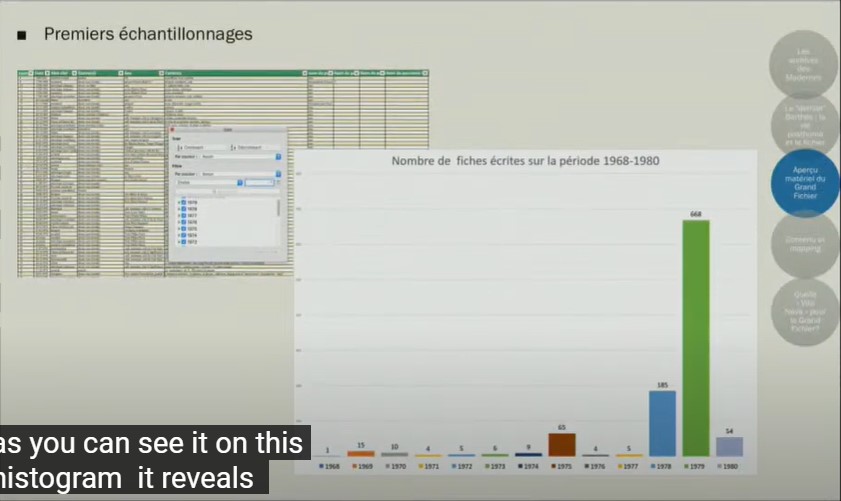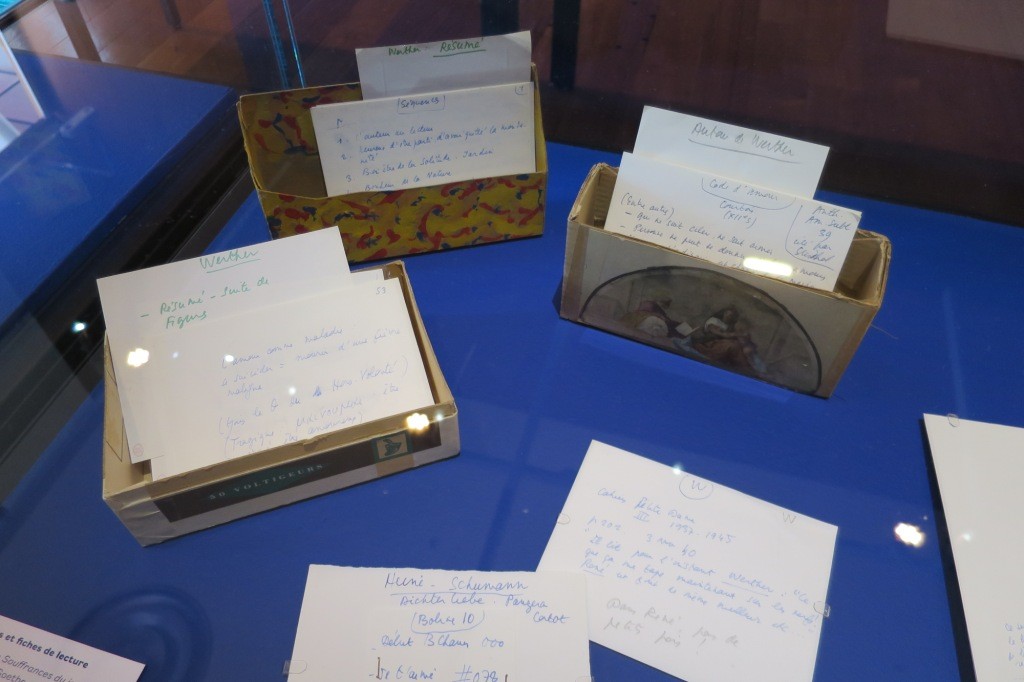Dans le fichier de Roland Barthes. Bibliothèque nationale de France, 2021. https://www.youtube.com/watch?v=eQX7jWqoq4o.
Watched 2023-03-03 at 11:55 AM
Dans le fichier de Roland Barthes. Bibliothèque nationale de France, 2021. https://www.youtube.com/watch?v=eQX7jWqoq4o.
Watched 2023-03-03 at 11:55 AM
Mathieu Messager imagines a digital archive of Roland Barthes' Grand Fichier, but as of 2021-05-05 it has not yet been realized. He presented an imagined version of it in his presentation at the BnF.
A few times in his Grand Fichier, Barthes includes notebook paper from other sources which he's cut down to fit into his box or clippings of newspapers which he's taped to cards and included. ᔥ [00:32:00]
partir de 78 79 mais plutôt 79 et 81 donc dans les derniers dans les deux dernières années de sa vie l'avant veille de son accident l'a dit les prises de notes sont alors beaucoup moins espacées dans le temps et bar peut écrire jusqu'à une quinzaine de fiches par jour voire plus on voit ici sur ce diagramme l'année 1979 avec véritablement un bon mois à l'été 79 ou [00:29:35]
In 1978/79 Roland Barthes was making up to 15 cards per day. ᔥ

Histogram of Roland Barthes fiches between 1968 and 1980 from [29:28]
Since it seems more natural, I'm switching tags from "Roland Barthes' zettelkasten" to "Roland Barthes' fichier boîte". Future me will have to cross-correlate these.
avoir cela à l'esprit c'est vraiment du format a6 je le disais ce sont des fiches des feuilles a4 que bart devait plier et découper et à avoir un stock ainsi de feuilles pourra noter ce qui lui passait par la tête tout ce qu'ils avaient envie d'écrire jour après jour donc de petits formats elles se disent aussi en mode paysage n'est pas en mode portrait elles portent quasiment toute la date au recto comme [00:28:08]
Barthes used A4 sheets which he folded and cut by hand to make A6 sheets for his notes. Most sheets are in landscape orientation and dated by hand in the top right corner, though some appear in portrait orientation presumably as tabs with the month and year centered in the top.
de l'ensemble de cet objet le fond et sa cotation je passe très brièvement le grand fichier on l'a dit se compose ainsi on le voit 2083 fiches manuscrites qui sont datés donc entre 1968 et 1980 et conservés depuis 2010 depuis le don de michel salzedo on a dit au département des manuscrits de la bibliothèque nationale sur le site richelieu toutes ces fiches sont contenues dans deux boîtes distincts qui apparaissent ici à gauche qui porte la cotation de la bibliothèque nationale nouvelle acquisition française 28 600 34 51 et 4,52 dans ces deux boîtes [00:27:01] (via autogenerated subtitles in French)
The Grand Fichier de Roland Barthes is composed of two boxes with 1083 handwritten cards and dated between 1968 and 1980.
il existe donc un sous ensemble composite qui porte le nom de grand fichier il est composé de d'environ 1000 feuillets et 1083 pour être exact [00:19:13]
The grand fichier of Roland Barthes contains 1083 fiches. ᔥ
There's something lovely about calling it le «Grand fichier» de Roland Barthes.
Fichiers et fiches de lecture autour des Souffrances du jeune Werther de Goethe
Files and reading sheets around the Sorrows of Young Werther by Goethe
And you thought your slip boxes were DIY?!?

Here is the description of the ‘Fichier vert’, which derives itsname from the fact that the titles of the rubrics are written ingreen ink. BNF, NAF 28630: ‘Fichier vert 1: Books, selectedpassages’, 363 index cards; ‘Fichier vert 2: Fragments completed’,501 cards; ‘Fichier vert 3: Fragments completed (continued)’, 300cards; ‘Fichier vert 4: Cards not used’, 325 cards; ‘Fichier vert 5:Discarded and/or for revision’, 300 cards; ‘Fichier vert 6:Discarded and/or for revision (continued to end), 300 cards.There is also a fichier on photography and a fichier entitled ‘Noteswithout a date’, some 200 cards that are ‘incidents’ and notesdrawn from the Urt diary in the summer of 1973 or the ‘harvestdiary’ kept by Barthes throughout the time he was writing thebook, in Paris, from autumn 1973 to spring 1974.
the Fonds Roland Barthesis called the ‘Grand fichier’
The Fonds Roland Barthes (English: The Roland Barthes Fund) at the Bibliothèque National De France refers to his card index or fichier boîte written from 1968-1980 as the 'Grand fichier'.
See also: https://archivesetmanuscrits.bnf.fr/ark:/12148/cc78608x/cN77017
These index cards,which Barthes began as a student, using them as a bibliographicaland then lexicographical resource, gradually became the place wherehe recorded a great deal of his life. In them, he assembled things hehad seen and heard, travel impressions, phrases that he liked, ideasand plans.
Roland Barthes used his card index as more than the traditional bibliographical, excerpting, and note taking tool that many had before him. He also used it to accumulate notes on what he had seen and heard in his daily life, phrases he liked, and plans. It came to serve the function, particularly in the last two years of his life, of a diary or what biographer Tiphaine Samoyault came to call his fichierjournal or index-card diary.
Are there examples of this practice before this time? Certainly in the commonplace book tradition, the ideas of journal, diary, and commonplace had been mixed before.
Bouttes contributedfrequently to Barthes’s seminar and gave an unusual paper at thecolloque de Cerisy called ‘Le diamantfoudre’ (‘The diamond-lightning’). He was darkly dazzling, strange, sombre, unexpected.Barthes thought he had something of Des Esseintes about him,witness an anecdote noted in his card index diary: ‘J.L.: in a phasewhere, in the restaurant, he deconstructs the menus, greatlyshocking the waiters. The other evening, at Prunier’s, oysters andoyster gratin, yesterday, at Le Balzar, oeuf en gelée and oysters,coffee ice cream and ice cream.’59
- BNF, NAF 28630, ‘Grand fichier’, 3 January 1975.
Roland Barthes' biographer Tiphaine Samoyault quotes portions of what he calls Barthes' card index diary.
This can also be seen in the published cards which comprise Barthes' Mourning Diary about the period following his mother's death.
Are there other people who've used their card index as a diary the way that some use it for productivity?
French theorist, philosopher, and writer Roland Barthes (1915 – 1980) kept a fichier boîte or card index file beginning in 1943 until his death. Curator Nathalie Léger has indicated that there are 12,250 slips in Roland Barthes' bequest at the Institut Mémoires de l’édition contemporaine (IMEC).[16][17] Louis-Jean Calvet explains that in writing Michelet, Barthes used his notes on index cards to try out various combinations of cards to both organize them as well as "to find correspondences between them."[18][19] In addition to using his card index for producing his published works, Barthes also used his note taking system for teaching as well. His final course on the topic of the Neutral, which he taught as a seminar at Collège de France, was contained in four bundles consisting of 800 cards which contained everything from notes, summaries, figures, and bibliographic entries.[18] In his autobiographical Roland Barthes par (by) Roland Barthes, Barthes reproduces three of his index cards in facsimile.[20] Published posthumously in 2010, Barthes' Mourning Diary was created from a collection of 330 of his index cards focusing on his mourning following the death of his mother. The book jacket of the book prominently features one of his index cards from the collection.[21] In a well known photo of Barthes in his office taken by Henri Cartier-Bresson in 1963, the author is pictured with his card indexes on the shelf behind him.[22][16]
French theorist, philosopher, and writer [[Roland Barthes]] (1915 – 1980) kept a ''fichier boîte'' or card index file beginning in 1943 until his death. Curator Nathalie Léger has indicated that there are 12,250 slips in Roland Barthes' bequest at the [[Institute for Contemporary Publishing Archives|Institut Mémoires de l’édition contemporaine (IMEC)]].<ref name="Hollier">{{cite journal |last1=Hollier |first1=Denis |title=Notes (On the Index Card). |journal=October |date=2005 |volume=112 |issue=Spring |pages=35–44 |url=https://www.jstor.org/stable/3397642 |access-date=23 April 2022}}</ref><ref>{{cite book |last1=Krapp |first1=Peter |editor1-last=Chun |editor1-first=W. H. K. |editor2-last=Keenan |editor2-first=T |title=New Media, Old Theory: A History and Theory Reader |date=2006 |publisher=Routledge |location=New York |pages=359-373 |chapter=Hypertext Avant La Lettre}}</ref> [[Louis-Jean Calvet]] explains that in writing ''Michelet'', Barthes used his notes on index cards to try out various combinations of cards to both organize them as well as "to find correspondences between them."<ref name="Rowan">{{cite journal |last1=Wilken |first1=Rowan |title=The card index as creativity machine |journal=Culture Machine |date=2010 |volume=11 |pages=7–30 |url=https://www.semanticscholar.org/paper/The-card-index-as-creativity-machine-Wilken/ffeae0931cc269da047d0844a6bef7e1c7424b46 |access-date=23 April 2022}}</ref><ref>{{cite book |last1=Calvet |first1=Louis-Jean |title=Roland Barthes: A Biography |date=1994 |publisher=Indiana University Press |location=Bloomington, IN}}</ref> In addition to using his card index for producing his published works, Barthes also used his note taking system for teaching as well. His final course on the topic of the Neutral, which he taught as a seminar at Collège de France, was contained in four bundles consisting of 800 cards which contained everything from notes, summaries, figures, and bibliographic entries.<ref name="Rowan"></ref> In his autobiographical ''Roland Barthes par (by) Roland Barthes'', Barthes reproduces three of his index cards in facsimile.<ref>{{cite book |last1=Barthes |first1=Roland |title=Roland Barthes |date=1977 |publisher=Macmillan |isbn=978-1-349-03520-5 |page=75}}</ref> Published posthumously in 2010, Barthes' ''Mourning Diary'' was created from a collection of 330 of his index cards focusing on his mourning following the death of his mother. The book jacket of the book prominently features one of his index cards from the collection.<ref>{{cite book |last1=Barthes |first1=Roland |title=Mourning Diary |date=2010 |publisher=Macmillan |url=https://us.macmillan.com/books/9780374533113/mourningdiary}}</ref> In a well known photo of Barthes in his office taken by [[Henri Cartier-Bresson]] in 1963, the author is pictured with his card indexes on the shelf behind him.<ref>{{cite book |last1=Yacavone |first1=Kathrin |title=Interdisciplinary Barthes |date=2020 |publisher=Oxford University Press |isbn=978-0-19-726667-0 |pages=97–117 |url=https://doi.org/10.5871/bacad/9780197266670.003.0007 |chapter=Picturing Barthes: The Photographic Construction of Authorship}}</ref><ref name="Hollier"></ref>
I am speaking here of what appear to be Barthes’ fichier boîte or indexcard boxes which are visible on the shelf above and behind his head.
First time I've run across the French term fichier boîte (literally 'file box') for index card boxes or files.
As someone looking into note taking practices and aware of the idea of the zettelkasten, the suspense is building for me. I'm hoping this paper will have the payoff I'm looking for: a description of Roland Barthes' note taking methods!